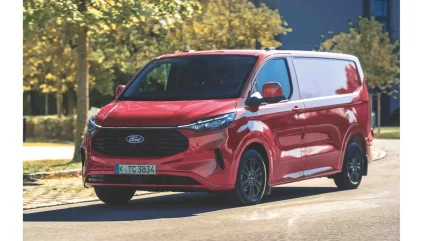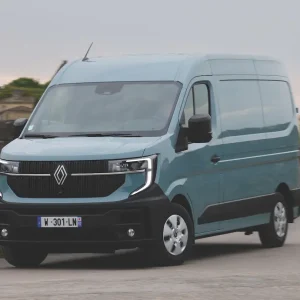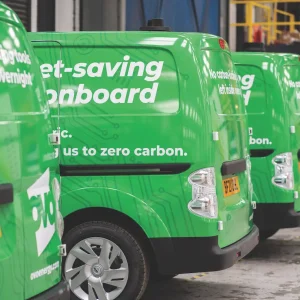
The Ford Transit Custom is not only by far the best-selling light commercial vehicle in the UK, it is also the nation’s most popular vehicle overall – a remarkable feat for a van. So when a new generation breaks cover, it is quite simply the most important product arrival of the year.
The Transit Custom range was already extensive, but when all derivatives have come to market, the new generation will boast the most comprehensive product range for the Custom to date: with panel van, double-cab-in-van, Kombi and Kombi van and the passenger-carrying Custom Tourneo up for grabs. New for 2024 will be a Camper Donor version and a versatile Multi-Cab van.
With an eye on the markets of today and the future, means of propulsion offered in the Custom line-up will include diesel, mild hybrid (MHEV) plug-in hybrid (PHEV) and battery electric (BEV). New Sport, Active and Trail models will complement the core specification grades, Leader, Trend and Limited.
Ford is offering diesel-powered Customs with front-wheel drive (FWD), while all-wheel drive (AWD) is offered on automatic variants. Customers needing enhanced traction on manual models can specify the 136hp or 150hp power outputs with a mechanical limited-slip differential.
PHEV comes with FWD and the BEV is rear-wheel-drive (RWD).
The manufacturer is launching the new Custom in three phases., with the first wave – which consists of FWD diesel Transit and Tourneo derivatives up to Limited/Titanium specifications – kicked off in October. Power comes from a 2.0-litre Ecoblue engine with outputs of 110hp, 136hp and 150hp when mated to a six-speed manual gearbox. An eight-speed automatic transmission will be available later coupled to 136hp and 170hp powertrains. Ford expects the 136hp and 150hp engines in Trend and Limited trim lines to be the best sellers.
Initially, the Custom is up for grabs in two lengths and one height, which is below 2.0 metres to facilitate access to multi-story car parks, loading bays and garages.
Production of the second wave of models will start in the first quarter of 2024 and will include AWD diesel vans as well as PHEV (petrol-electric) Custom Transits and Tourneos, which have a claimed electric-only range of up to 34 miles. It will also see the introduction of Multicab, DCiV, Kombi, Sport, Trail, Active and Titanium X versions. The new Multicab layout features an L-shaped bulkhead to allow for the transportation of long items while also retaining two second-row passenger seats.
The third wave includes high roof vans and the BEV models, production will start in Q2 2024, with deliveries beginning in the summer. The BEV will get a 64kWh battery and 100 or 160kW electric motors and a maximum range of 209 miles.
Ford says diesel vans have a towing capacity of 2.8-tonnes whereas PHEV and BEV vans can haul up to 2.3-tonnes.
Ford took feedback from its customers to pack the Transit Custom range with a wealth of features that are designed to make operators’ working days easier, listening in particular to the concerns of small business users.
Most eye catching among the new additions is the new tilting steering wheel that takes the tried and trusted concept of the mobile office to a new level. The wheel’s squared off rim rotates to become a stand for tablets and laptops, as well as a flat-topped table to make paperwork easier and lunch breaks more comfortable. Another clever design tweak in the cabin sees the passenger airbag installed in a roof-mounted position to free up more storage space to create a far deeper glovebox in the dashboard.
To help busy delivery drivers who make multiple drops during their working days, Ford will introduce the Delivery Assist pack in October 2024 to increase efficiency and reduce tiredness by automating processes that would otherwise take up more time and energy.
Delivery Assist activates when the driver shifts into park, automatically switching on hazard lights, closing open windows and locking the door once the driver leaves the van. Upon returning, the driver can keylessly enter and start the vehicle. The hazard lights will switch off and the windows will return to their previous positions. The pack will be available as an option for £325.
A generous provision of ADAS includes cross traffic assist, reverse brake assist, 360-degree camera, and intelligent adaptive cruise control with stop and go technology on automatic models to make driving less taxing in heavy traffic.
All new Transit Customs are installed with the Ford Pro platform of software and connected services, including management tools from Ford Pro Telematics that encompass the Ford Pass Pro app for small businesses and Ford Liive for larger fleets.
Also on offer is a suite of lock packs developed in conjunction with security specialist TVL.
Medium Van of the Year
Having been crowned our overall Van of the Year, it follows that the Transit Custom also won its category: Medium Van of the Year.
We drove the FWD L1H1 Transit Custom 320 panel van in Limited trim powered by the 2.0L 150hp Ecoblue turbodiesel engine, which is likely to be the core model in the UK.
The engine delivers power smoothly and responsively in all driving environments, is quiet and operates in harmony with the slick six-speed manual gearbox and sure-footed steering that provides plenty of feedback to the driver. The steering wheel itself, which is adjustable for reach and rake, is on the rectangular side, but then again, it is designed to transform into a table.
We also got to sample the eight-speed automatic transmission. It is impressively refined but we can see no reason why customers opting for the manual should regret their choice.
As we are becoming used to with Ford’s LCVs, performance and handling are class leading.
The 13in touchscreen dominates the cabin and provides a clear view for the Satnav and the excellent reversing camera. The controls are straightforward and easy to understand. And there is no need to feel digitalised to death as there are also some good old-fashioned knobs and buttons, too, including those mounted on the steering wheel. A 12in digital instrument cluster in the dashboard complements the touchscreen and imparts information to the driver clearly, without forcing them to take their eyes off the road. The driver’s seat is four-way adjustable and heated, as are the passenger seats.
The interior is roomy and offers great cross-cab access, which is an impressive trait of Ford’s medium and large vans. The cabin in the van tested here was protected from the cargo area by a full-height bulkhead.
Twin rear doors plus a near-side loading door provide access to the load bay, an offside loading door can be specified if desired. An integrated step makes it easier to get in and out of the side door and the load bed floor is protected by a moulded lining. Six tie-down points are fitted to help secure loads.
Highly Commended Medium Van: Renault Trafic
Renault has updated its Trafic with no corresponding increase in its pricing. The medium van now comes with active emergency braking, lane departure warning, driver attention alert, and tyre pressure monitoring as standard. Models specified with the Extra trim level now feature a hands-free key card and automatic high beam assist as standard equipment. In addition, Extra Sport versions now feature adaptive cruise control and 360-degree parking sensors as standard.
With the Trafic E-Tech complementing the compact Kangoo E-Tech and large Master E-Tech, Renault has a full line-up of electric vans. It features a 52kWh battery that delivers a range of up to 186 miles on the WLTP cycle – although Renault claims this can get close to 230 miles if the van is confined to purely urban routes. An Eco mode optimises range and a ‘Long Range’ mode limits speed to 56mph but stretches WLTP range to a claimed 200 miles. Load volumes span from 5.8m3 to 8.9m3, and top payload across the Trafic E-Tech range is 1,100kg.





